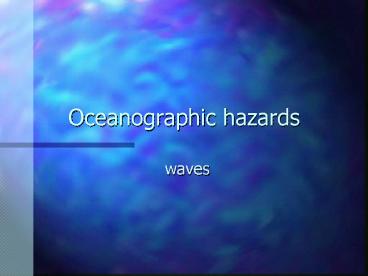Oceanographic hazards PowerPoint PPT Presentation
1 / 39
Title: Oceanographic hazards
1
Oceanographic hazards
- waves
2
Wave Hazards
- One of the principal causes of destruction when
associated with Storm events or Earthquakes. - But even in the absence of extreme events waves
also cause coastal erosion. - Global warming and the associated sea-level rise
will exacerbate the problems.
3
Wave characteristics
4
- Height , H, is the vertical distance between
trough and peak or crest. - Amplitude, a, is half the height - being the
distance between the undisturbed water level and
the peak. - Wavelength, ? , is the distance between two
crests measured in the direction of propagation
(perpendicular to the line along the crests). - Period, T, of a wave is the time interval which
elapses between the arrival of successive crests
at a fixed location.
5
Speed, c ? /T. Frequency, ? 1/TSpeed, c ?
?
6
Wave Energy
Proportional to the square of the height
Proportional to the wavelength
7
Water Wave Spectrum
Earthquakes, Tropical Cyclones
Sun Moon
Wind
12 hours
5 mins
1 sec
30 secs
0.1 sec
Wave Period
tides
Tsunami Storm surges
10-6
10-5
10-4
10-3
10-2
10-1
1
10
Wave frequency (Hz)
8
(No Transcript)
9
Capillary waves generated by gusts of wind
ripple pattern dissipated in less than 30 secs
by viscosity. Min velocity 2.3 cm/s, with
wavelength 1.7cm
10
Waves in this band are generated by turbulent
surface wind stress quickly damped with depth
h is the water depth
11
Gravity Waves
12
Gravity Waves spectrum dependence on fetch
Distances in km
13
Tsunami
- Speed gt200m/s in deep ocean (4km), 30m/s on
continental shelves about 100m deep, period 5-60
minutes - Wavelength 200km
14
Tidal Wave Hits Portsmouth!
A wave of length 20,000km, height of 2m and
period 12hrs 25mins hit Portsmouth early this
morning, it has now drawn back and is expected to
strike again this evening.
Period
Time
15
Causes of Tsunami
- Large scale, high energy disturbance of water
- Extraterrestrial object impact
- Submarine Earthquakes
- Landslides (submarine or into water)
- Volcanoes sector collapse-pyroclastic flows
16
Properties of Tsunami
- Wave train composed from waves of wavelength up
to 200km, depending on the source. - Height about 1m in mid ocean. Period 5-60
minutes. - Little energy loss due to turbulence.
- Speed gt720km/h in deep ocean, (4km) around
108km/h on continental shelves (100m deep). - Non-dispersive (keep their shape).
- Transoceanic c.f. earthquakes cause damage
within a few hundred kilometers
17
Nicaragua (1992) simulation
18
Propagation is affected by bathymetry
19
Chile May 22nd 1960 (M9.5)
http//www.phys.port.ac.uk/units/2005/hazards/wave
s/globe.mov
Mutsu (Japan) 6m Hilo (Hawaii) 10.7m Isla Mocha
(Chile) 25m Valparaiso (Chile) 1.7m
http//wcatwc.arh.noaa.gov/web_tsus/19600522/runup
s.htm
20
Sumatra Simulation
Distribution of energy depends on initial shape
and ocean bathymetry
http//www.noaanews.noaa.gov/video/tsunami-indones
ia2004.mov
21
Sumatra tsunami energy
1013 m3 (104 km3 ) or 1016 kg of water uplifted
by several metres. Increase in Potential Energy
of 1017 Joules or 108 tons of TNT 1011 Jm-1 c.f.
wave on Southsea beach about 102 Jm-1)
22
Approaching the Shore
Waves slow down, wavelength decreases and height
increases as they approach the shore.
23
Approach to the Shore
- Behaviour of the wave depends on both shore
profile and size of wave. - In most cases tsunami break and form a turbulent
surge. - But rarely Tsunami do not break on the shore and
can be more like a rapid tide. (first waves
formed in 1964 Alaska and 1992 Nicaragua Tsunami)
24
Long wavelength and period, high speed and small
height
Wavelength and speed reduced, but energy stays
constant so height increases
200km
Front of the wave slows and is caught up by the
rear, wave becomes steeper
Height drops as waves spread out in two dimensions
25
wavelength and speed reduced height increased
Long wavelength and period, high speed
Wave steepens as shore is approached
26
Velocity in turbulent surge
1ms-1 (3kmh-1) Southsea Beach
18ms-1(64kmh-1) for 9m Tsunami
27
Run-up/Run-in
- Non breaking waves run up to their height (like
tides). - Breaking waves have additional forward momentum
which enables higher run in. Run-Innundation
determined by friction with beach. - 200 slope, run up is typically twice initial wave
height - Vertical cliff, 5 times initial height
28
(No Transcript)
29
Scotch Cap lighthouse 1/4/1946
The wave ran over a 32m cliff behind the
lighthouse
30
Lituya bay 1958
Landslide generated tsunami direction more
focussed greater runup between 1 and 10km
wavelength and between 1 and 5 minutes periods
31
Storegga submarine slides
- 3 slides 5580km3 of sediment collapsed along
290km of continental slope off Norway travelled
over 500km across the sea floor at velocities up
to 50ms-1 - First slide 30,000 yrs ago, last two 6,000 and
8,000 yrs ago - Affected Scotland, Norway, Iceland and Greenland
32
Bryant E A. (2001) Tsunami. CUP
33
Tsunami Warning System
Comprised of 26 participating international
Member States, has the functions of monitoring
seismological and tidal stations throughout the
Pacific Basin to evaluate potentially
tsunamigenic earthquakes and disseminating
tsunami warning information
The Alaska Tsunami Warning Center
The Pacific Tsunami Warning Center in Ewa Beach,
Hawaii,
34
Pacific Tsunami Warning System
35
1994 Mindoro
The magnitude 7.1 Mindoro earthquake was
tsunamigenic. The tsunami hit approximately 40-km
of the northern and eastern shoreline of Mindoro
island from Puerto Galera up to Pinamalayan. Also
affected by tsunami were islands north of Mindoro
mainland, namely Verde Island and Baco Islands.
Minor oscillation of waves was also reported at
Batangas Bay.
The tsunami wave train formed at least 3 large
waves with varying magnitude. Most of the people
interviewed claimed that the first wave was the
strongest and the succeeding waves were smaller
36
(No Transcript)
37
http//www.pmel.noaa.gov/accomp/fy98/fm1_andreanov
.jpg
38
1960 Hilo Tsunami Hawai'i
39
Links
http//www.geophys.washington.edu/tsunami/welcome.
html
http//www.tsunami.org

